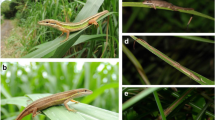Summary
Anolis limifrons is a small iguanid lizard that is found in lowland rainforest in Central America. Important life attributes include early maturity (3–4 mo), multiple clutches of a single egg per breeding season, and low survival. Population turnover is essentially annual as less than 5% adults live more than one year. My objectives were to resolve the following specific questions: 1) Where are eggs laid? 2) Does survival differ among different types of oviposition site? 3) How is the survival of eggs related to the density and age distribution of lizards at different areas? Most eggs are laid beneath litter on the ground. Eggs laid aboveground are placed in accumulations of soil and litter in stumps, crevices in buttressed trees and vines, holes in trees, and on the tops of logs. Eggs were found in aboveground sites in proportion to the abundance of those sites. The major cause of mortality was predation by Solenopsis ants. Judging by the ratio of eggs known to have hatched to those that were predated, survival did not differ among the various types of oviposition site. Study areas with high egg survival in the middle of the wet season had relatively more young (<4–6 mo old) lizards at the end of the wet season than areas with low egg survival. The strong correlation between the relative number of young individuals and egg survival is a consequence of the seasonal cycle of growth and reproduction. Most eggs are laid in the wet season (May–December). Hatchlings complete growth during the dry season (January–April) and become reproductive adults in their second wet season. However, because hatchlings can grow to reproductive size in approximately 3 months, individuals that hatch early in the wet season may themselves produce offspring that will be <4–6 mo old in the late wet season. The relative survival of juveniles (eggs) and adults is an important datum for many theories of life history evolution. For A. limifrons, survival of eggs was two to three times more variable than survival of lizards on both temporal and spatial scales. Comparative data for reptiles are not available to put this information into an evolutionary prespective.
Similar content being viewed by others
References
Andrews RM (1982a) Patterns of growth in reptiles. Pages 273–320 in: Biology of the Reptilia (eds. C. Gans and F.H. Pough), Vol. 13 Physiology D: Physiological Ecology, Academic Press, NY
Andrews RM (1982b) Spatial variation in egg mortality of the lizard Anolis limifrons. Herpetologica 38:165–171
Andrews RM, Rand AS (1982) Seasonal breeding and long-term population fluctuations in the lizard Anolis limifrons. In: Leigh EG, Rand AS, Windsor DM (eds). The ecology of a tropical forest: seasonal rhythms and long-term changes. Smithsonian Institution Press, Washington, D.C., pp 405–412
Andrews RM, Rand AS (1983) Limited dispersal of juvenile Anolis limifrons. Copeia 1983:429–434
Andrews RM, Rand AS, Guerrero S (1983) Seasonal and spatial variation in the annual cycle of a tropical lizard. In: Rhodin AGJ, Miyata K (eds). Advances in herpetology and evolutionary biology, essays in honor of Ernest E. Williams. Museum of Comparative Zoology, Harvard University, Cambridge, pp 441–454
Andrews RM, Sexton OJ (1981) Water relations of the eggs of Anolis auratus and Anolis limifrons. Ecology 62:556–562
Case TJ (1982) Ecology and evolution of the insular giant chuckwallas, Sauromalus hispidus and Sauromalus varius. In: Burghardt GM, Rand AS (eds). Iguanas of the world: their behavior, ecology, and conservation. Noyes Publications, Park Ridge, NJ, pp 184–212
Dunham AE (1982) Demography and life history variation among populations of the iguanid lizard Urosaurus ornatus: implications for the study of life history phenomena in lizards. Herpetologica 38:208–221
Foster RB, Brokaw NVL (1982) Structure and history of the vegetation of Barro Colorado Island. In: Leigh EG, Rand AS, Windson DM (eds). The ecology of a tropical forest: seasonal rhythms and long-term changes. Smithsonian Institution Press, Washington, D.C., pp 67–81
Rand AS (1967) Communal egg laying in anoline lizards. Herpetologica 23:227–230
Schaffer WM (1974) Optimal reproductive effort in fluctuating environments. Am Nat 108:783–790
Sexton OJ, Heatwole H, Knight D (1964) Correlation of microdistribution of some Panamanian reptiles and amphibians with structural organization of the habitat. Caribb J Sci 4:261–295
Siegel S (1956) Nonparametric statistics for the behavioral sciences. McGraw-Hill Book Co., New York
Sokal RR, Rohlf FJ (1981) Biometry: the principles and practice of statistics in biological research. WH Freeman and Co., New York
Stearns SC (1976) Life-history tactics: a review of the ideas. Quart Rev Biol 51:3–47
Stearns SC (1977) The evolution of life history traits. Ann Rev Ecol Syst 8:145–171
Talbot JJ (1975) Preliminary egg mortality studies in two species of tropical anoline lizards. Herp Rev 6:73
Taylor RJ, Regal PJ (1978) The peninsular effect on species diversity and the biogeography of Baja California. Am Nat 112:583–593
Tinkle DW, Wilbur HM, Tilley SG (1970) Evolutionary strategies in lizard reproduction. Evolution 24:55–74
Tinkle DW, Congdon JD, Rosen PC (1981) Nesting frequency and success: implications for the demography of painted turtles. Ecology 62:1426–1432
Wright SJ, Kimsey R, Campbell CJ (1984) Mortality rates of insular Anolis lizards: a systematic effect of island area? Am Nat 123:134–142
Author information
Authors and Affiliations
Rights and permissions
About this article
Cite this article
Andrews, R.M. Demographic correlates of variable egg survival for a tropical lizard. Oecologia 76, 376–382 (1988). https://doi.org/10.1007/BF00377032
Received:
Issue Date:
DOI: https://doi.org/10.1007/BF00377032




